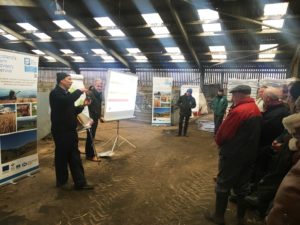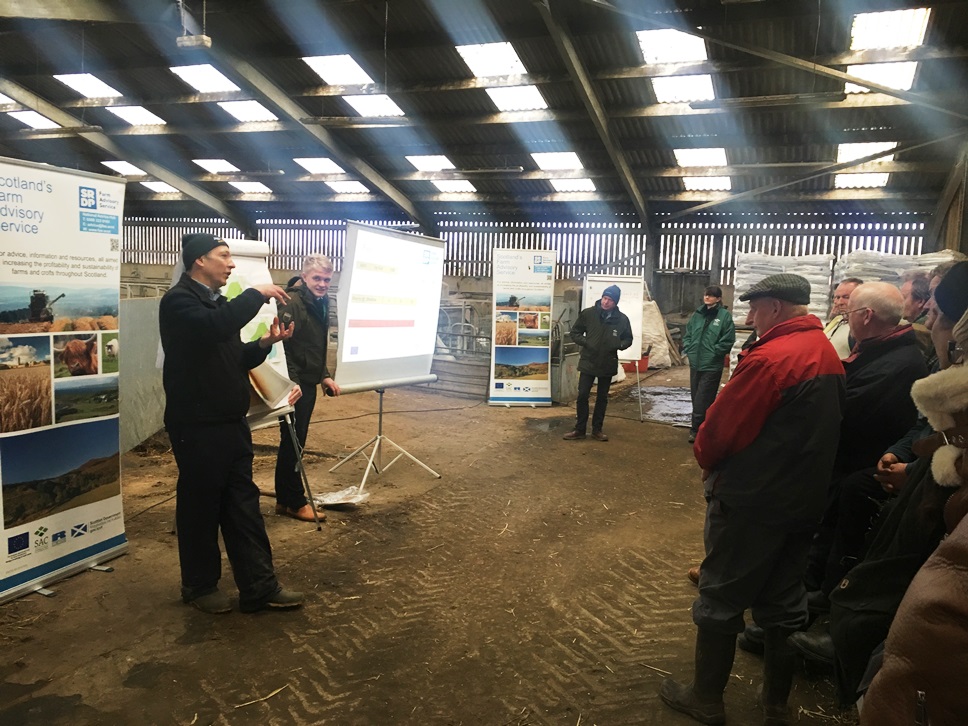Stirling Soil & Nutrient Network: 2nd meeting – event summary
13 February 2019This was the second meeting of the Stirling Soil & Nutrient Network. The focus for the event was how effective nutrient budgeting can save you money!
All farms should work with a dynamic nutrient budget – one that is created and regularly checked and reviewed to ensure it remains effective. The event began with a workshop style theme where the group discussed the organic fertilisers available at Aucheneck. This was followed by a presentation by Robin Mair on how to achieve good nutrient management where he revelled at the thousands of pounds that could be saved at Aucheneck by reduced fertiliser costs from an effective nutrient budget.
From the calculations, the combined requirement for purchased NPK fertilsers was significantly less than what is currently being used across all of the farms within the estate since the plant nutrient requirements are currently being predominantly fulfilled by the slurry and dung  applications.
applications.
Later in the afternoon, Paul Hargreaves discussed soil quality and the characteristics everyone should be aware of within the farm. When discussing the soil biological health, he revealed how having a mixed species of earthworms was a vital component of maintaining soil quality. Soil compaction reduces worm numbers considerably and Paul was able to highlight how getting to know your soil through a VESS and knowing your soil type can help identify areas that are compacted. Once identified remediation can be done using suitable equipment for the level of compaction and under the right conditions. Paul also discussed the effectiveness of using cover crops and how they can improve soil health and fertility. Whilst it may seem counter-intuitive to plant a crop only to only plough it into the soil again a few months later, but the nutritional benefits for the soil and the following crop are massive, not to mention the benefits of preventing soil erosion or biodiversity for insects and farmland birds.
More information about some of what was discussed can be found in the downloads at the bottom of this page.
- Technical Note (TN664): Management of Cobalt in Grassland Soils
- Topics: Soils
- Technical Note (TN668): Managing Soil Phosphorus
- Efficient soil P management is challenging due to the varying ability of soils to mediate and regulate plant available forms of P. Farmers and land managers in Scotland are now able to access farm level information about their soils making it possible to provide more accurate P management advice.
- Topics: Crops and Soils
- Technical Note (TN699): Agricultural use of Biosolids, Composts, Anaerobic Digestates and other Industrial Organic Fertilisers
- Organic fertilisers such as biosolids, composts, anaerobic digestates and industrial wastes can be useful and cost-effective crop nutrient sources that can improve soil quality. This technical note outlines their use in agriculture.
- Topics: Climate Change, Soils and Water Management
- Farming For A Better Climate: Practical Guide – Improving Soil Quality
- This Practical Guide concentrates on how we can improve soil quality to help us to adapt to climate change.
- Topics: Soils
- Practical Guide: Nutrient Budgeting II – Getting Started
- This practical guide looks at what factors you need to consider when making a nutrient budget for your farm, fertiliser recommendations and how to get the most out of your nutrient budget.
- Topics: Climate Change
- Practical Guide: Nutrient budgeting I – The Benefits to your Business
- This practical guide looks at the benefits of creating and using a nutrient budget for your farm business.
- Topics: Climate Change
- OPAL – Grassland earthworm key
- This is a two-sheet guide to identifying earthworms.
- Topics: Soils, Crofts & Small Farms and Environment
- AHDB: An introduction to earthworms guide
- AHDB: An introduction to earthworms guide
- Topics: Climate Change, Soils, Water Management and Crops and Soils
Sign up to the FAS newsletter
Receive updates on news, events and publications from Scotland’s Farm Advisory Service

